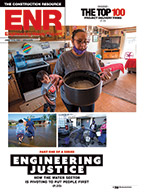Many changes related to right-of-way issues that had been resolved differently than originally planned in previous years, adds Gwynne. And because it was a design-build contract—an atypical procurement approach for rail projects—updating design wasn't easy.
"You need a lot of data to be collected from the field to really analyze what's out there," Gwynne says. "Because it's an active rail corridor, you can't just run out whenever you want to get survey. You have to collect your survey as you can, between trains."
For all those reasons, the redesign—which included an all-new signal system for the 32-mile stretch—was slow to evolve. Two federal agencies and a third-party railroad, CSX, had to review all design decisions. That further complicated matters.
FDOT, as a brand-new railroad owner, proceeded cautiously. "There was a little more hesitancy" in the beginning, says Ed Fenn, deputy project manager for RailWorks. "It took some time to fine-tune expectations and requirements and provide an acceptable product to the owner."
Construction Crunch
The design delay squeezed the time for construction. Making up time was tough, especially around an active railroad, say team members.
"Ensuring all of the construction is done safely, while meeting our timetables, is a balancing act," says Amy Scales, FDOT's resident engineer.
The 70-plus grade crossing reconstructions were the biggest challenge. Scheduling the work on the line, which crosses myriad jurisdictions, was the first headache. The team had to coordinate with various municipalities, agencies and utilities that own and operate facilities along the corridor.
Some grade crossings—where no adjustments to existing track or realignment were required—were fairly straightforward. "We could just put in our new track, and the train traffic could still operate," says Gwynne.
More vexing were the major grade crossing reconfigurations that required shutting down all train service for a period called an "extended curfew," typically 54 hours. Generally, the work involved track crews—backed by civil support—removing the old rail, excavating down to subgrade and then rebuilding the crossing over the course of the first 24 to 36 hours. Once that was done, workers were sent home to sleep.
On the second day, paving crews rebuilt the roadway. A rested track team then returned to install pre-panelized sections of track, assembled by RailWorks. Track testing and inspection occurs throughout and again prior to re-opening the corridor to train traffic.
Planning the curfew work was often the most difficult part of the job, says Lapp. Each curfew required a week of meetings during which the team would nail down an hour-by-hour work plan for each crew.
Because most of the curfews occurred nearly back-to-back, "We'd work seven days a week for a couple of months straight," Lapp says. "It was pretty intense."
The work at a grade crossing provided the justification for any single curfew. But the joint venture team would take advantage of the situation and deploy dozens of other work crews up and down the line while it was inactive.
In addition to the grade-crossing work, RailWorks' Fenn says the overall plan for the curfew also "typically contained 20 to 30 different smaller activities along the alignment to take full advantage of that time."










